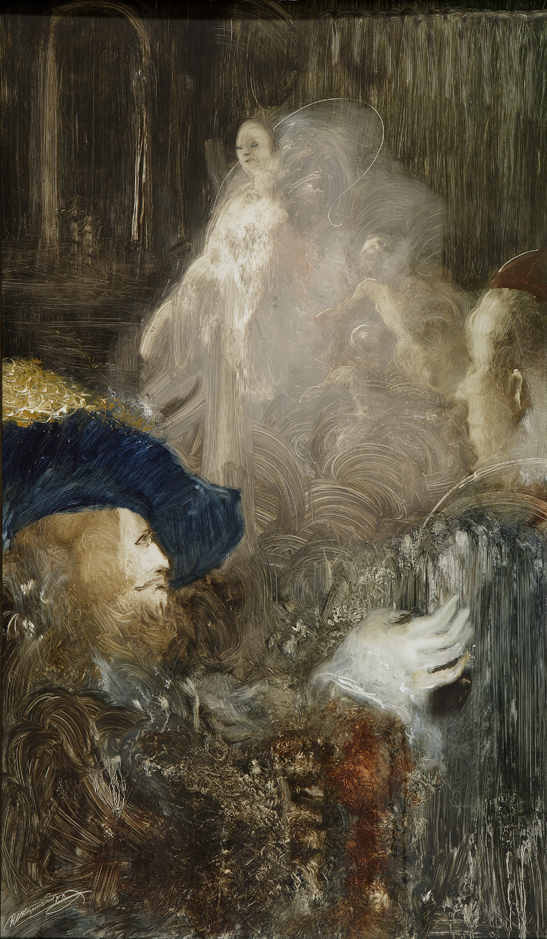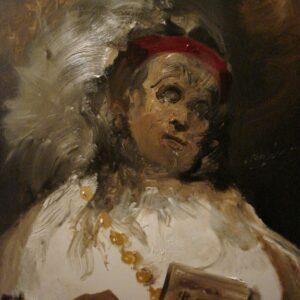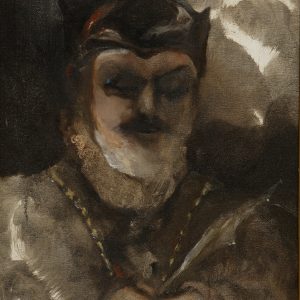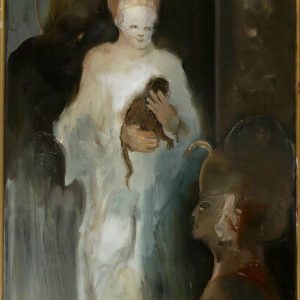Description
Artist/Maker: Kostas Kampouropoulos (1939-2018)
Object/Materials and Techniques: Oil on Laminated Wood
Date: Painted between 2007-2016
Dimensions: H. 47 cm. x W. 28 cm.
Art style: Romantic Visionism / Abstract Expressionism / Minimalism
Current Location: Private collection
Curator’s note: This painting constitutes a homage to Mary II, Queen of England, Scotland and Ireland (1662-1694), known for the co-reigning with her husband, William III (from 1689 until her death in 1964). William and Mary became King and Queen Regnant, and were crowned joint sovereigns.
Queen Mary is depicted in the background, in front of the entrance of Saint James’s Palace, the most important senior royal palace in the United Kingdom, and the most important residence of the British royal family (until Queen Victoria moved to Buckingham Palace in 1837).
In the foreground, the figure on the right is the Archbishop of Canterbury, and on the left the 1st Duke of Marlborough, John Churchill, then still an Earl, ancestor of Winston Churchill.
The Queen refuses to listen to the Earl, whom later she imprisoned, but after her death, her sister and successor, Anna, anointed him Duke (1702).
The idea for this painting was given rise to Kostas Kampouropoulos by the wonderful music theme of Henry Purcell, An Elegy Upon The Death Of Queen Mary, which was also used at the composer’s burial at Westminster Abbey in 1965. Henry Purcell was one of the greatest English composers whose style was a uniquely English form of Baroque music.
Therefore, being himself passionate about lyrical music and classical sounds, Kostas Kampouropoulos chose to employ in the painting such strategies of musical composition as the melodies of lyrical tones. Softly abstracted forms and colour gradations aspire to emulate musicality and provoke contemplation. The viewer experiences the artist’s characteristic style of gentle colour scheme and delicately brushed contours, through which he succeeds in evoking out of the portrayed royal scene sound emotional effect.
The technique of fuzzy outline and the absence of crisp lines that strongly describe not only the artist’s present oeuvre but also his total output constitutes a practice widely used in Romanticism, the movement of which Kostas Kampouropoulos is influenced the most throughout his career.
As he points out in his book For the Painting (2013): ‘Romanticism, as an abstraction, as a pole of attraction, an aid to the expansion but also to the understanding of many situations, emotional and psychological, in which, it can’t be helped, I was sometimes attracted by my sensitive and prone to all kinds of colours and melancholy nature, was and certainly is an element that permeates my work end to end, even if it is not explicitly acknowledged.’
As so, in the present painting, through his romanticistic style, adapted in a very personal and modern edition, Kostas Kampouropoulos manages to blur the line between fantasy and reality. Cupids fade in the tulle of the Queen’s veil within an overall shadowy composition that succeeds in conveying a sense of a dreamy poetic reverie in the form of a fascinating psychological queenly drama.
In addition, of great importance is the artist’s distinguishing intension to demonstrate the clothing of the stately era that, in the case herein, give the impression, in a keen and discriminating manner, of theatrical costumes of an opera scene. Affectingly impressive within space, the portrayed characters act like performing a role, upon what one would view as a stage, and transcend the ‘audience’ to another scenery that springs synchronously from palatine history and fantasy. Executed in high calibre refinement, and depicted with impressive technical artistic skills via masterfully painted brushstrokes, the pictured 17th century noble attire of the figures grants the overall canvas a distinct classical splendour and a lavish basil ‘aura’ that constitutes a true ‘Reference To Queen Mary’, worthy of her regal and majestic status.
Professor Nikos Zias once has written about Kostas Kampouropoulos work that one of its main and most significant features is that it has a ‘theme’, meaning that it refers to a story of a person or an event, which is explicitly stated as the title of the work, and usually derives from the Western-European area of the past.
However, as Professor Nikos Zias further observes: ‘…his painting is not historical or iconographic, but symbolic and confessional, his reflection is personal, modern and authentic. And that’s why in the end his paintings have, due to colour unity and balance, their justification within modern creation.’
Bibliographic References:
- Κωνσταντίνος Ι. Καμπουρόπουλος, Για τη Ζωγραφική, Αθήνα, Εκδοτικός Οργανισμός Πάπυρος, 2013, pp. 126-128.
- John Van der Kiste, William and Mary, Stroud, Gloucestershire, Sutton Publishing, 2003, ISBN 0-7509-3048-9.
- Marcel Brion, Art of the romantic era: romanticism classicism, realism, New York, Praeger Publishers, 1966.
- Kevin J. Avery & Diane P. Fischer, American Tonalism: Selection from the Metropolitan Museum of Art and the Montclair Art Museum, Burlington Magazine, Vol. 142, 2000, p. 453.





